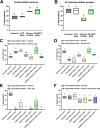An odorant-binding protein functions in fire ant social immunity interfacing with innate immunity
- PMID: 39933575
- PMCID: PMC11813584
- DOI: 10.1098/rsob.240254
An odorant-binding protein functions in fire ant social immunity interfacing with innate immunity
Abstract
Social immunity-mediated sanitation behaviours occur in insects when microbially killed corpses are removed and/or dismembered by healthy nestmates. However, little is known concerning the chemical signals or receptor proteins that mediate these responses. Here, we identify cuticular components in the eusocial red important fire ant, Solenopsis invicta: behenic acid, which induces dismemberment behaviour, and oleic and cis,cis-9,12-linoleic acids, which inhibit dismemberment in a process mediated by S. invicta odorant-binding protein-15 (SiOBP15). Yeast two-hybrid screening and protein-protein interaction analyses identified the ant immunity-related proteins apolipophorin-III (SiApoLp-III) and fatty acid binding protein-5 (SiFABP5) as SiOBP15 interacting partners. SiOBP15 and SiFABP5 bound all three dismemberment-related compounds, whereas interactions between SiOBP15 and SiApoLp-III narrowed binding to behenic acid. RNAi-mediated gene expression knockdown of SiOBP15, SiApoLp-III or SiFABP5 revealed that behenic acid chemoreception determines dismemberment behaviour via SiApoLp-III/SiOBP15, whereas SiOBP15 or SiOBP15/SiFABP5 recognition of linoleic acid inhibits dismemberment behaviour. These data identify a host circuit linking olfactory proteins and proteins involved in innate immunity to control the degree of sanitation behaviour elicited in response to microbial infection. We identify specific chemical cues transduced by these proteins, providing a mechanism connecting olfaction-related processes to innate immunity, host-pathogen interactions and social immunity.
Keywords: Solenopsis invicta; apolipophorin-III; fatty acid binding protein; immunity and olfaction; odorant-binding protein; sanitation behaviour.
Conflict of interest statement
We declare we have no competing interests.
Figures






References
-
- Plowes N. 2010. An introduction to eusociality. Nat. Educ. Knowl 3, 7.
-
- Pereira RM, Stimac JL. 1992. Transmission of Beauveria bassiana within Nests of Solenopsis invicta (Hymenoptera: Formicidae) in the Laboratory. Environ. Entomol. 21, 1427–1432. (10.1093/ee/21.6.1427) - DOI
-
- Schmid-Hempel P. 1998. Parasites in social insects. Princeton, NJ: Princeton University Press. (10.1515/9780691206851) - DOI
MeSH terms
Substances
Grants and funding
LinkOut - more resources
Full Text Sources

